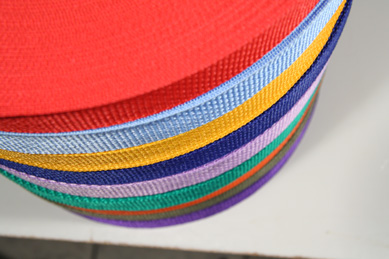Nylon, Polypropylene, and Polyester Webbing

Comparing Webbing

Webbing is a very strong fabric that is either a flat strip or a tube. People can use webbing for different things, such as home arts and crafts. Industrial or commercial polyester webbing, polypropylene webbing, and nylon webbing are very common webbing materials. Each of these webbing types have advantages and also disadvantages. Soft, lustrous nylon comes in neon and basic colors. Polyester webbing is available in beautiful patterns through the process of sublimation. Polypropylene or "polypro" combines the best of nylon and polyester.
Dye
Nylon webbing is typically a very strong type of webbing, and is usually colored very brightly. It will, however, lose color if left in the sun too long. Very old nylon webbing may appear to be dull, patchy, or pale looking in color. Polyester webbing color is typically much lighter. A colorfast polyester webbing will not bleed color. Polypropylene webbing is typically used in the food industry, with medical equipment, and also many children's products. The dye in polypropylene webbing is very resistant to any type of bleeding, and it also does not lose its color. It is very easy to clean and resists absorbing any odors.
Strength
Polyester and nylon webbing are typically very strong. Polypropylene webbing, on the other hand, is not as strong. Polypropylene will float in water, however, and is great to use as a tie down, such as batteries, as it withstands battery acid very well. Polyester webbing as a lower breaking point when compared to nylon webbing of the same type. Nylon webbing is much weaker when it is wet, however. Nylon webbing will stretch while it is damp or wet. Polyester webbing can be wet and still be a very strong webbing.
Durability
Polyester, nylon, and polypropylene webbing are all very durable webbing materials. Nylon webbing is especially known for its durability and strength. This type of webbing is most commonly used in making dog leashes, safety belts, luggage straps, and many sports products. Both polypropylene and polyester webbing are very similar to nylon webbing, but are much lighter and less expensive. It is much easier to sew because it is lighter. This type of webbing is most commonly found on dog leashes, backpacks, and handbags.
You can find a handy reference chart in From the Mailbag at Country Brook Design® that compares nylon, polypro, and polyester webbing materials.Common Uses
Nylon webbing is a very durable and strong material that is used in a wide variety of different products. Racecar drivers use this type of webbing for seat belts. Military personnel use this type of webbing in their backpacks. This webbing material is also used in outdoor furniture seat suspension. It is also used in dog leashes and dog collars. Nylon webbing is also used in child safety seats as the harness. Polyester and polypropylene webbing are typically used for the same types of products. The most common product this type of webbing is used for is seat belts. It is also used in backpacks and lawn chairs. Rock climbers mainly use polyester webbing because it has much less stretch than polypropylene webbing.
There are many differences between polyester, polypropylene, and nylon webbing, but there are also many things about the webbing that is the same. The main differences in the webbing is the amount of stretch that you get with the webbing, the strength of the webbing and the durability of the webbing. If you look around your home, you will more than likely see many different types of webbing in your own backyard, and inside of your home. if you use lawn equipment, you'll recognize shoulder and carrying straps made of some type of webbing. Your own casual purse, backback, or reusable shopping bag probably incorporate webbing material, too!

